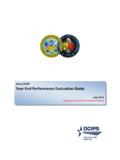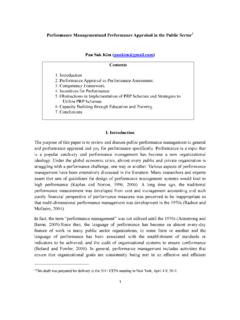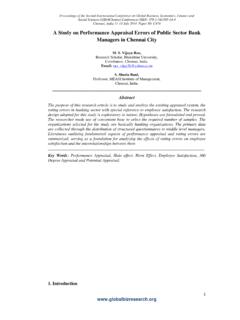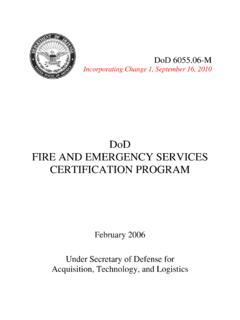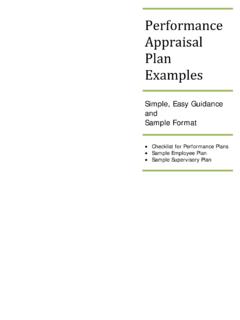Transcription of Successful Faculty Performance in Teaching, Research and ...
1 2010 Florida State University Successful Faculty Performance in Teaching, Research and Original Creative Work, and Service1 James P. Sampson, Jr., Marcy P. Driscoll, David F. Foulk, and Pamela S. Carroll2 Dean of the Faculties Office Florida State University3 April 26, 2010 Success as a university Faculty member is dependent on having a clear understanding of how to combine the elements of teaching, Research and original creative work, and service in a way that makes the best use of the time and resources available. Faculty members are expected to make substantive contributions to the learning of their students and to their field, as well as to make service contributions to their field and the university. Faculty members are more likely to make substantive contributions when they have well-defined goals and a specific plan for reaching those goals. The purpose of this paper is to clarify the elements of Successful Faculty Performance at a Research -extensive university.
2 Faculty members can use this paper to regularly plan and evaluate their work, as well as discuss their work with a department chairperson and a mentor. Faculty members can also use this paper to help them prepare personal statements for third-year and promotion and tenure reviews. Academic administrators, Research center directors, department chairpersons, members of departmental evaluation committees, and members of promotion and tenure committees can use this paper to clarify their criteria for evaluating Faculty Performance . Mentors can use this paper to help Faculty better understand the nature of Successful Performance . Faculty search committees can use this paper to clarify the expectations for Performance to candidates for Faculty positions. Academic administrators responsible for new Faculty orientation can use this paper as a starting point for clarifying Performance expectations in specific colleges, schools, departments, and programs.
3 1 This paper provides the basis for several Faculty development documents, including: Self Evaluation of Faculty Performance in Teaching, Research and Original Creative Work, and Service; Writing Personal Statements for Faculty Evaluations; Activities and Topics for Faculty Mentoring; Using Personal Statements in Faculty Evaluations; Guidelines for Teaching Observation Letters; Guidelines for Writing Annual Evaluation Letters for Faculty Members; and Guidelines for Writing Promotion and Tenure Letters for Faculty Members. (Citations for these documents are available in the reference section of this paper.) 2 Author information is provided at the end of this document. 3 314 Westcott Building, 222 S. Copeland Avenue, Tallahassee, FL 32306-1480, (850) 644-6876, Successful Faculty Performance 2 Faculty Performance is most often expressed in terms of teaching, Research and original creative work, and service.
4 This paper is organized according to these categories. Specific elements of Successful Faculty Performance are presented in Table 1. Table 1 Elements of Successful Faculty Performance in Teaching, Research and Original Creative Work, and Service ---------------------------------------- ---------------------------------------- ------------------------------------- Teaching Effectiveness of Course Delivery Quality of Course Content Effectiveness in Developing and Managing Instruction Quality of Course Development Quality of Curriculum Development Effectiveness in Managing Multiple Course Sections Effectiveness in Mentoring Students Effectiveness of Academic Advising Using Research and Original Creative Work to Enhance Teaching Using Service to Enhance Teaching Research and Original Creative Work Quality of Research and Original Creative Work Programmatic Nature of Research or Focus of Original Creative Work Sustainability of Research and Original Creative Work Productivity in Research and Original Creative Work Using Teaching to Enhance Research and Original Creative Work Using Service to Enhance Research and Original Creative Work Service Service to the Institution Service to the
5 Profession Service to Society through Consultation Using Teaching to Enhance Service Using Research and Original Creative Work to Enhance Service Faculty members work varies considerably, reflecting the different fields represented in a large doctoral Research university. Differences also exist in the percentage of time Faculty members allocate to teaching, Research and original creative work, and service. Faculty members can be appointed in tenured, tenure-earning, or non-tenure earning positions. As a result of these differences, the specific elements of Faculty work included in this paper are more relevant for some Faculty members than others. This paper begins with a discussion of the benefits of synergy among teaching, Research and original creative work, and service and continues with an examination of the nature of Successful Performance and resources available to enhance Faculty work. Benefits of Synergy among Teaching, Research and Original Creative Work, and Service Synergy allows one aspect of Faculty work to complement another aspect of Faculty work.
6 For example, Faculty members Research and original creative work can become part of the Successful Faculty Performance 3content in a course they teach. Taking advantage of synergy allows Faculty members to achieve outcomes that would not otherwise be possible. Synergy also allows Faculty members to better use the time they invest in their work. Given the high expectations for Performance , Faculty members need to take advantage of synergy in their work whenever possible. The descriptions of synergy among teaching, Research and original creative work, and service that are included in this paper are only examples. Evidence of synergy among teaching, Research and original creative work, and service is shown in letters from department chairs and personal statements for third-year and promotion and tenure reviews. Successful Performance in Teaching Performance in teaching is examined in relation to effectiveness of course delivery, quality of course content, effectiveness in developing and managing instruction, effectiveness in mentoring students, effectiveness of academic advising, and using Research and original creative work and service to enhance teaching.
7 Effectiveness of Course Delivery Effectiveness of course delivery involves the extent to which a Faculty member can lecture, lead discussion, respond to student questions, evaluate assignments, use instructional technology, and provide individualized assistance to students when requested. For courses involving clinical practice, effectiveness also includes supervision. Evidence of the effectiveness of course delivery is shown in student course evaluations and teaching observations provided by senior Faculty . Evidence of the effectiveness of course delivery can also be shown in portfolios of students work at the end of the semester. Quality of Course Content Quality of course content involves the extent to which knowledge presented is valid. Course content includes: a) course readings, b) instructor-developed resources, c) class exercises, d) clinical practice, and e) experiments. The quality of course content may also involve skill acquisition as appropriate for the goals of the course.
8 Evidence of quality in course content is shown in student course evaluations, program or departmental Faculty review of course syllabi and instructor-developed resources, and external reviews of course syllabi and resources by experts in the field. As was the case with the effectiveness of course delivery, the quality of course content can be further shown by portfolios of students work. Effectiveness in Developing and Managing Instruction Quality of Course Development. Course development refers to creating a new course or making substantive revisions, such as developing a distance learning component or Web-based learning resources. Evidence of quality in course development is shown by program or departmental Faculty review of course syllabi and instructor-developed resources, as well as external reviews of course syllabi and resources by experts in the field. Quality of Curriculum Development. Curriculum development includes designing new courses, distance learning programs, certificate programs, majors, and degree programs.
9 Curriculum development does not include the normal ongoing development of an existing course. Quality in designing instructional resources involves creating documents, media, and software that enhance student learning in courses. Quality of course design involves the extent to Successful Faculty Performance 4which content sequencing, class activities, assignments, use of information and communication technology, and examinations promote student learning. Quality in designing majors and degree programs involves creating sequences of content courses and clinical practice that lead to the development of competencies appropriate for a field of study or profession. Similar to the quality of course content, evidence of quality in curriculum development is shown by program or departmental Faculty review of course syllabi and external reviews of course syllabi by experts in the field. Further evidence of quality in curriculum development is evident in the accreditation or re-accreditation of a professional degree program, such as in education, law, medicine, nursing, psychology, and social work.
10 Effectiveness in Managing Multiple Course Sections. Management of multiple course sections involves coordinating the ongoing design, development, and delivery of instruction for a course having several sections that are taught by various Faculty members, graduate students, or adjunct Faculty . Responsibilities typically include leadership in development and/or selection of course materials, revision of course content based on evaluations, selection of instructors, and arrangement of instructional technology for the course. When the course is taught by graduate students or adjunct Faculty members, regular supervision and evaluation of instructors may be involved. Evidence of effectiveness in managing multiple course sections can be seen in the adequacy of aggregate teaching ratings for the course, the resources and strategies created by the Faculty member in managing the course, evaluation of the course manager by the instructors, and supervisory resources created for the course (such as orientation materials).

